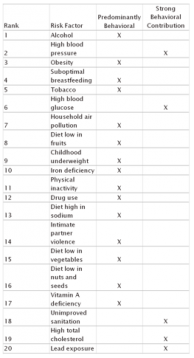Behavior Change Communication: A Requirement for Effective Health Programming

Ixchen, an NGO providing women’s health services, promotes affordable mammography and ultrasound with a banner outside Ixchen’s center in the outskirts of Managua, Nicaragua. © 2002 Alfredo L. Fort, Courtesy of Photoshare
Most if not all health interventions require an element of behavior change. As noted in Dr. Jim Shelton’s August 2013 editorial “The 6 domains of behavior change: the missing health system building block” in the Global Health: Science and Practice Journal, 15 of the top 20 health risk factors in sub-Saharan Africa are predominantly behavioral, and the other five are highly influenced by behavior. (See the table [1] at right for the data.)
In your own life, think about some of the health-related messages that you hear or see on a daily basis that aim to convince us to change your behavior. For example:
“Fasten your seat belt.”
“Don’t litter.”
“Don’t drink and drive.”
“Get a mammogram.”
“Brush your teeth.”
“Use a bed net.”
“Eat more nutritious foods.”
In order to ensure that the health-related messages are effective in changing one’s behavior, they should be based on social and behavioral science theories, which attempt to explain the role of specific determinants and sources of influence on human behaviors. In addition, behavior change communication messages often need to appeal to emotions as well as logic. For example, messages about smoking causing bad breath and reducing virility may be more effective than messages about smoking causing lung cancer, depending on the target audience and their age range.

Global Burden of Disease 2010: Top 20 Risk Factors, Sub-Saharan Africa. Source: Lim et al. (see fn. 1)
Messages should describe:
- The primary audience – who should take action.
- A call to action – what the audience should do.
- A key promise – a single, subjective benefit that the audience will experience if they take the desired action.
- A support statement – how an individual will achieve the desired action.
To learn more about health communication messaging and designing, implementing, and monitoring and evaluating a health communication intervention, take the new Global Health eLearning course on Health Communication for Managers.
This blog originally appeared April 9 on K4Health.
1 Table drawn from Lim S. S., Vos T., Flaxman A. D., Danaei G., Shibuya K., Adair-Rohani H., et al. A comparative risk assessment of burden of disease and injury attributable to 67 risk factors and risk factor clusters in 21 regions, 1990–2010: a systematic analysis for the Global Burden of Disease Study 2010. Lancet. 2012;380(9859), 2224–2260.








Leave a Reply
Want to join the discussion?Feel free to contribute!